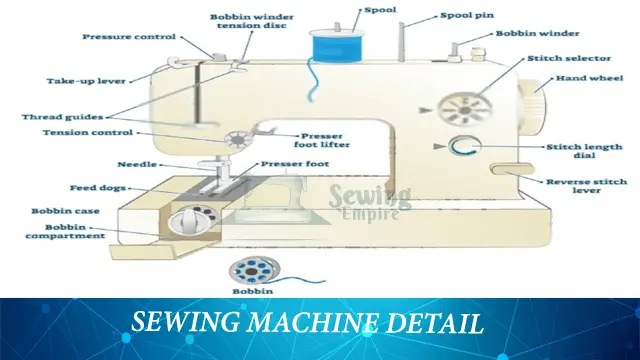Do you know how your sewing machine creates stitches? It locks the thread from the bottom bobbin and top needle. And if that does not happen, then it becomes a nightmare for both experienced sewers as well as beginners.
In this article, we will learn why your device is unable to complete these tasks and solutions on what could be wrong so that you can get back to creating new clothes.
The tension on the machine is a decisive factor in whether or not it can catch the thread. If you have too much pressure, then nothing will be caught and no stitches will form.
Too little, however, means that all your fabric could easily bunch up and get stuck at one end of the needle’s eyelet hole when trying to start stitching!
This article has tips for adjusting both cases so as to stitch like an expert.
Why Sewing Machine Stitches Not Catching ?
If you’re having a problem with your sewing machine, it could be due to various reasons. It may happen because of improper bobbin placement or dirt in the case; it’s possible that there is any other reason for this issue too.
Make sure to read below if you need more help on how to fix these problems!
Reasons – Why Sewing Machine Not Stitching?
The basics of making stitches involve the needle passing through your machine’s throat and grabbing thread from the bottom bobbin. That way, you make a stitch on your fabric!
What happens when that does not happen?
It leaves you with many questions as to why there are no stitches being made- and it’s usually because something is wrong with either one or both parts.
There could be lint in between two bobbins which would keep them apart; dust blocking any contact between needles and threads; knots interfering around where they should go inside the device (which can cause more issues); broken gears preventing all of this action from taking place…and so much more!

1. Thread Issue
Yes, I’m sure you know how to thread a bobbin! But did you actually find out the right way of doing it? For the top thread on your machine and lower twist threads with no knots (or at least not too many) produce stitches that are smooth and lock together.
Threading your bobbins correctly will make all this possible: looser winding in one direction makes for better results when sewing as properly threaded bobbins can be wound tight or loose depending on what type of fabric is being sewn.
2. Thread Tension
The right tension is key in ensuring your stitches have a perfect balance. Stitch too tight and you risk breaking threads before they are locked together, or if it’s loose then there will be a loss of neatness to the point where stitches can come undone easily with movement.
3. Dirty Shuttle Case
How dirty are your sewing machine surfaces and throat plate? Making fabric involves a lot of cutting and tearing. Dirt, debris, and pieces of materials build up inside the shuttle area which obstructs the thread path making it not move swiftly.
4. Machine Timing Issue
Did you know that if your sewing machine isn’t catching thread, it might be because the timing is off? When the timing of a sewing machine wheeling away from rather than towards you causes misalignment in belt and gear.
The needle and bobbin hook may not meet at their optimum time to make stitches, which leads to improperly sewn seams or clothes with loose threads.
But don’t worry! Routine service by an experienced technician will fix this problem for good–helping ensure perfect stitching every time.
5. Poor Quality Thread
With so many companies trying to make a profit, it’s difficult finding the right balance between price and quality.
But I think we can all agree that going for cheap threads is not worth it in the long run since they break easily or cause problems with your machine.
Solution: How To Fix Sewing Machine Not Stitching
To avoid sewing problems, make sure to use the proper needle size for your fabric. If you’re not using a spool of thread with an eyed end on it at all times, try switching out between two or three in order to prevent knots from happening as often.
Make sure that any time you switch needles is done carefully and slowly so as not to damage them!
To get rid of those pesky knot-tying machines we like so much here at Sew What’s Next? Here are some steps:
1. Check The Bobbin
As said earlier, the bobbin has a tooth that catches and pulls in an upper needle thread. In order to make sure it works properly you need to wind your yarn around the spool-shaped object correctly so there are no loose threads or knots pulling on one another.
You also want to be careful not to tighten any of them because they will eventually cause jamming issues for your machine; instead, loosen all until you find just enough tension where everything is running smoothly through without snags!
2. Rethread Your Upper Thread
One helpful tip when threading is to take a few steps back. Thread can easily get messed up and this may lead to it coming loose from the machine.
To make sure you don’t miss anything, undo everything on top of your sewing machine and re-enter keenly–that might be what fixes that problem!
3. Check The Needle
The needle is the key part of your sewing machine that helps you make neat and perfect stitches.
Yes, it’s easy to notice a bent needle because probably it won’t go through the pressing foot but what happens if it is bent? That can be one of the causes for your stitching not catching thread so how do you fix this disaster?
These are some tips: firstly replace any worn-out or poorly aligned needles; secondly, use appropriate size needles depending on fabric being sewn (such as small ones for light fabrics); thirdly try different types of settings with tension dials like zigzag stitch mode which may help catch threads better than straight line sew setting.
4. Tension
Knowing how to adjust the tension on my sewing machine is crucial for a successful project.
Different fabrics have different tensions in order to create perfect stitches, so it’s important that you know what your fabric needs and thread well before setting the right amount of pressure with this function button here called “Tension.”
Before stitching anything else make sure you test out using a spare piece of fabric; if everything feels like it will work just fine then go ahead!
5. Change Your Fabric
Sometimes your machine might not be catching the thread due to what type of fabric you’re working on.
Try a different material and see if it helps! If that’s not the problem, then try changing some techniques so that you can handle this particular kind of fabric better.
6. Check Thread Type
Those of you who have sewn before know that the quality of your thread is a major factor in how well your project comes out. Cheap threads break more often and jam up on lower-quality machines.
You’re better off using high-quality yarn for sewing projects to make sure it doesn’t get caught or end up causing any damage either – especially if you want those intricately patterned seams!
The only thing standing between an excellent piece of work and something less than stellar might just be what kind of fabric you are stitching with; remember: good things come from high-quality materials like quilting fabrics too!
How to Thread Bobbin Correctly on a Sewing Machine?
After winding the thread into a bobbin, you can easily reach the top of your sewing machine by gently lifting it to find and threading the needle.
Once threaded properly with both threads attached at opposite ends of one large hole in each end-ring, press them through until they come out on either side for stitching together.
What Should You Check When Sewing Machine Not Stitching The Thread?
The first step to fixing a jammed sewing machine is checking the needle and bobbin. Make sure that both are of size, straight, and in their proper place before moving on to threading check for any knots or dirt which can cause jamming!
Last but not least make sure your tension is okay by turning it all the way up and then down again from time to time.
Some Last Words
It’s true that sewing can be both fun and frustrating, but when your stitches don’t work then the frustration levels go up. Troubleshooting stitch issues will make it less of a hassle as you avoid those annoying emotions.
Most stitch problems are common and can be solved simply quickly before resorting to more complicated or expensive fixes- like using professional repairers for example!

Robert Patricia
Robert Patricia is a data analytic and content creator. He has worked extensively with large data sets to glean insights for both public and private sector clients. He has used this knowledge to create compelling content for brands across the internet. Albert also enjoys creating content for websites and social media. He is an expert at creating catchy headlines and understands how to capture the attention of readers.
